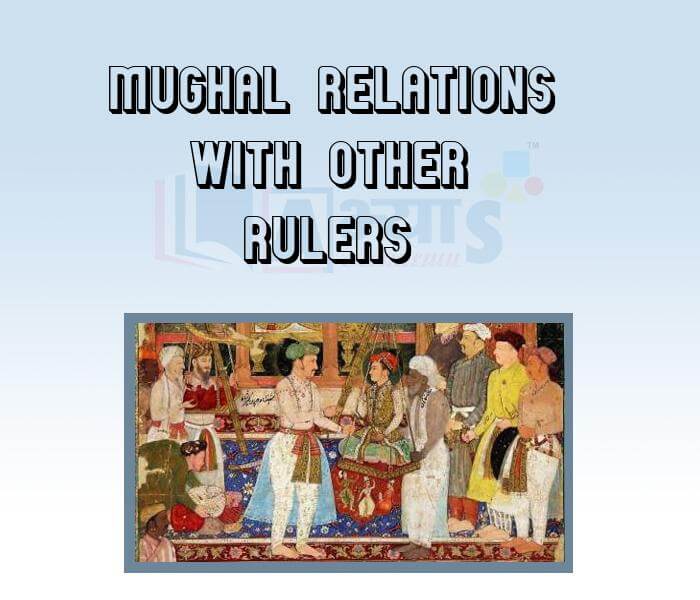Mughal Relations with Other Rulers












Mughal Relations with Other Rulers
Mughal Relations with Other Rulers:
It was a policy of Mughal rulers campaigned constantly against rulers who refused to accept their authority. But as the Mughals became powerful many other rulers also joined them voluntarily. The rajputs are a good example of this. Many of them married their daughters into Mughal families and received high positions. But at the same time , many resisted the Mughals. The sisodiya rajputs refused to accept Mughal authority for a long time. Once defeated, however, they were honorably treated by the Mughals, given their lands back as assignments.Watan back as a assignments,Le Watan Jagir .Thus Mughals never humiliated their opponents even defeated them.
The careful balance between defeating but not humiliating their opponents enabled the mughals to extend their influence over many kings and chieftains.
The main reasons Mughal maintain a good relationship with Rajputs because:
Rajput Policy is another reason of relation with Mughal's.
Babur and Humayun had strained relations with the Rajputs. It was only Akbar who rightly perceived that the Rajputs were a very brave and courageous people who could not be easily crushed by warfare. He therefore set himself to the task of winning over the Rajputs. He entered into a scheme of matrimonial alliances with the Rajputs. He started giving high positions to the Rajputs in Mughal service and treated them on par with the Mughal nobility.
He granted freedom of worship and conscience to the Rajputs. Those who allied themselves to Akbar were largely left in charge of their kingdoms. Where conciliation failed he resorted to warfare. His policy of 'carrot and stick' won over the Rajputs and they became a part and parcel of the Mughal empire.
Jahangir continued the Rajput policy of his father. In the reign of Shah Jahan also the Rajputs continued to serve the empire though they did not have the prominent position which they enjoyed at the time of Akbar. Aurangzeb negated the earlier policy and thereby undid the work of Akbar. He turned valuable friends into dangerous foes.
Second, the areas towards the north and south of Rajputana were fertile, and potentially a source of substantial revenue. This area was criss-crossed by important trade routes running between Gujarat and the north Indian plain.
Finally, Rajputana also contained a number of formidable forts, legendary for their capacity to withstand sieges, such as Chittor and Ranthambhor.
Students / Parents Reviews [10]
It was a good experience with Abhyas Academy. I even faced problems in starting but slowly and steadily overcomed. Especially reasoning classes helped me a lot.

Cheshta
10thAbhyas Methodology is very good. It is based on according to student and each child manages accordingly to its properly. Methodology has improved the abilities of students to shine them in future.

Manish Kumar
10thMy experience was very good with Abhyas academy. I am studying here from 6th class and I am satisfied by its results in my life. I improved a lot here ahead of school syllabus.

Ayan Ghosh
8thI have spent a wonderful time in Abhyas academy. It has made my reasoning more apt, English more stronger and Maths an interesting subject for me. It has given me a habbit of self studying

Yatharthi Sharma
10thMy experience with Abhyas is very good. I have learnt many things here like vedic maths and reasoning also. Teachers here first take our doubts and then there are assignments to verify our weak points.

Shivam Rana
7thAbhyas is a complete education Institute. Here extreme care is taken by teacher with the help of regular exam. Extra classes also conducted by the institute, if the student is weak.

Om Umang
10thBeing a parent, I saw my daughter improvement in her studies by seeing a good result in all day to day compititive exam TMO, NSO, IEO etc and as well as studies. I have got a fruitful result from my daughter.

Prisha Gupta
8thMy experience with Abhyas academy is very good. I did not think that my every subject coming here will be so strong. The main thing is that the online tests had made me learn here more things.

Hiya Gupta
8thIt has a great methodology. Students here can get analysis to their test quickly.We can learn easily through PPTs and the testing methods are good. We know that where we have to practice

Barkha Arora
10thIt was good as the experience because as we had come here we had been improved in a such envirnment created here.Extra is taught which is beneficial for future.
